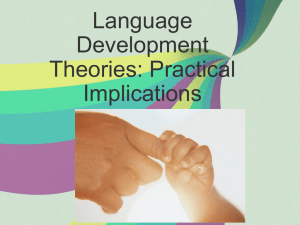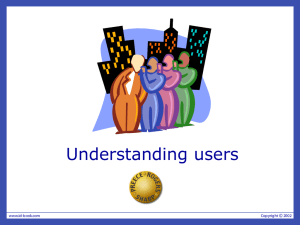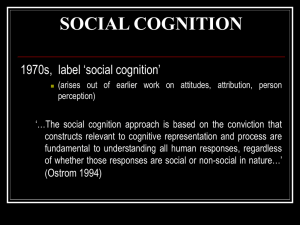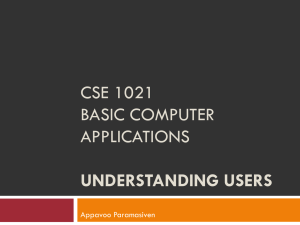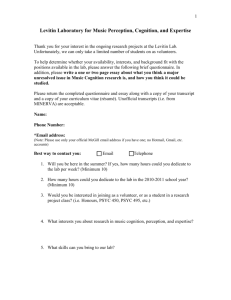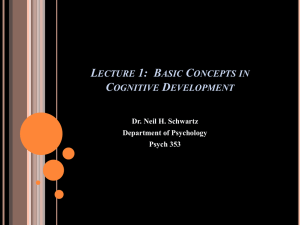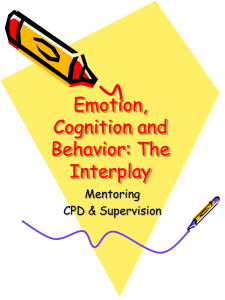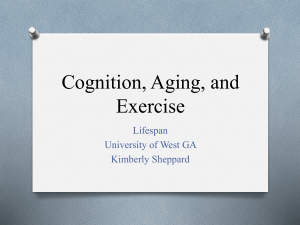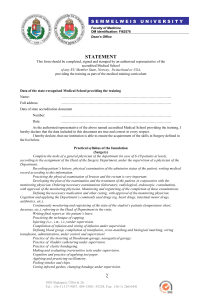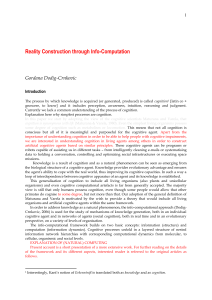Modeling Life as Cognitive Info
advertisement
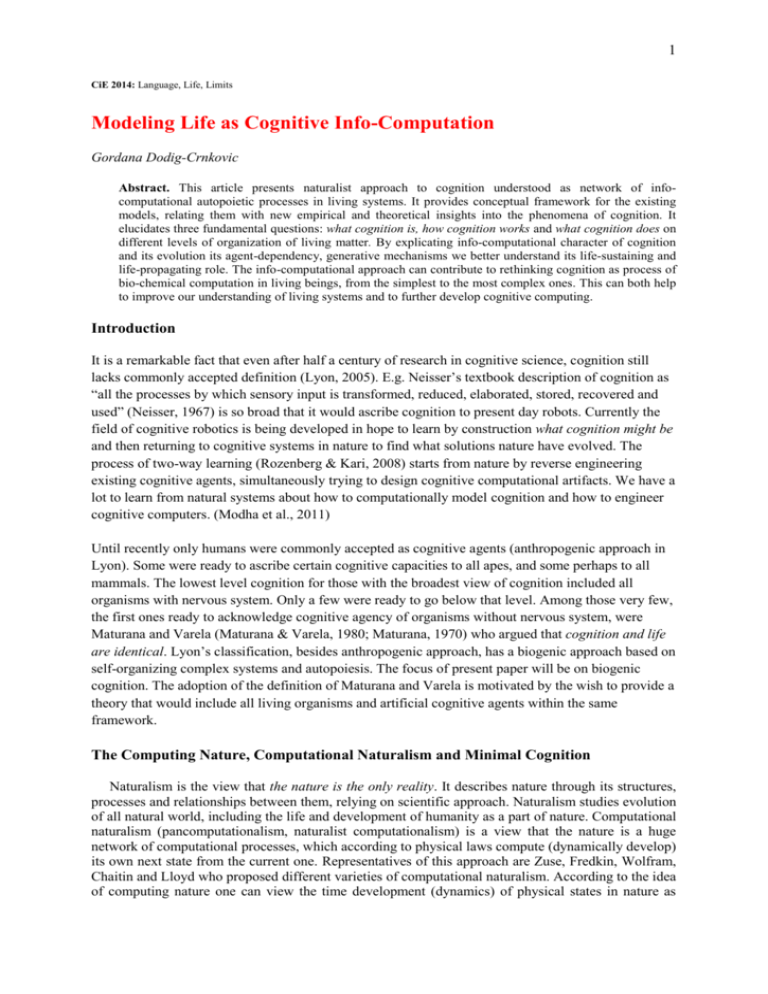
1 CiE 2014: Language, Life, Limits Modeling Life as Cognitive Info-Computation Gordana Dodig-Crnkovic Abstract. This article presents naturalist approach to cognition understood as network of infocomputational autopoietic processes in living systems. It provides conceptual framework for the existing models, relating them with new empirical and theoretical insights into the phenomena of cognition. It elucidates three fundamental questions: what cognition is, how cognition works and what cognition does on different levels of organization of living matter. By explicating info-computational character of cognition and its evolution its agent-dependency, generative mechanisms we better understand its life-sustaining and life-propagating role. The info-computational approach can contribute to rethinking cognition as process of bio-chemical computation in living beings, from the simplest to the most complex ones. This can both help to improve our understanding of living systems and to further develop cognitive computing. Introduction It is a remarkable fact that even after half a century of research in cognitive science, cognition still lacks commonly accepted definition (Lyon, 2005). E.g. Neisser’s textbook description of cognition as “all the processes by which sensory input is transformed, reduced, elaborated, stored, recovered and used” (Neisser, 1967) is so broad that it would ascribe cognition to present day robots. Currently the field of cognitive robotics is being developed in hope to learn by construction what cognition might be and then returning to cognitive systems in nature to find what solutions nature have evolved. The process of two-way learning (Rozenberg & Kari, 2008) starts from nature by reverse engineering existing cognitive agents, simultaneously trying to design cognitive computational artifacts. We have a lot to learn from natural systems about how to computationally model cognition and how to engineer cognitive computers. (Modha et al., 2011) Until recently only humans were commonly accepted as cognitive agents (anthropogenic approach in Lyon). Some were ready to ascribe certain cognitive capacities to all apes, and some perhaps to all mammals. The lowest level cognition for those with the broadest view of cognition included all organisms with nervous system. Only a few were ready to go below that level. Among those very few, the first ones ready to acknowledge cognitive agency of organisms without nervous system, were Maturana and Varela (Maturana & Varela, 1980; Maturana, 1970) who argued that cognition and life are identical. Lyon’s classification, besides anthropogenic approach, has a biogenic approach based on self-organizing complex systems and autopoiesis. The focus of present paper will be on biogenic cognition. The adoption of the definition of Maturana and Varela is motivated by the wish to provide a theory that would include all living organisms and artificial cognitive agents within the same framework. The Computing Nature, Computational Naturalism and Minimal Cognition Naturalism is the view that the nature is the only reality. It describes nature through its structures, processes and relationships between them, relying on scientific approach. Naturalism studies evolution of all natural world, including the life and development of humanity as a part of nature. Computational naturalism (pancomputationalism, naturalist computationalism) is a view that the nature is a huge network of computational processes, which according to physical laws compute (dynamically develop) its own next state from the current one. Representatives of this approach are Zuse, Fredkin, Wolfram, Chaitin and Lloyd who proposed different varieties of computational naturalism. According to the idea of computing nature one can view the time development (dynamics) of physical states in nature as 2 CiE 2014: Language, Life, Limits information processing (natural computation). Such processes include self-assembly, selforganization, developmental processes, gene regulation networks, gene assembly, protein-protein interaction networks, biological transport networks, social computing, evolutionary processes and similar processes of morphogenesis (creation of form). The idea of computing nature and the relationships between two basic concepts of information and computation are explored in (DodigCrnkovic & Giovagnoli, 2013) (Dodig-Crnkovic & Burgin, 2011). In the computing nature, cognition should be studied as a natural process. If we adopt the biogenetic approach to cognition, the important question is what is the minimal cognition. Recently numbers of empirical studies have revealed unexpected richness of cognitive behaviors (perception, information processing, memory, decision making) in as simple organisms as bacteria. Single bacteria are too small to be able to sense anything but their immediate environment, and they live too short to be able to memorize significant amount of data, so of interest for us are bacterial colonies, swarms and films that have shown to possess unanticipated complexity of behaviors which can be characterized as “minimal cognition”. (Duijn, Keijzer, & Franken, 2006) (Ben-Jacob, Shapira, & Tauber, 2006; BenJacob, 2008, 2009) (Ng & Bassler, 2009; Waters & Bassler, 2005) Unlike Maturana and Varela’s view of cognition as life, (Duijn et al., 2006) proposed that minimal cognition can be identified with sensorimotor coordination. However, ven though fundamental, sensorimotor coordination is not enough. Autopoietic, chemical processes of cognition based on molecular computation are essential, not only for simple organisms like bacteria, but also for functions of human nervous system. Apart from bacteria and similar organisms without nervous system, even plants are typically taught of as living systems without cognitive capacities. However, plants have been found to possess memory (in their bodily structures that change as a result of past events) and the ability to learn (plasticity, ability to adapt through morphodynamics), anticipate and direct their behavior accordingly. Plants are argued to possess rudimentary forms of knowledge, according to (Pombo, O., Torres J.M., Symons J., 2012) p. 121 (Rosen 1985) p. 7 and Popper (Popper, 1999) p. 61. Notice that in the similar way as we ascribe a degree of cognition to all living organisms, we might ascribe a degree of consciousness in a sense of self-perception (Goertzel, 1994), and it would of course not imply consciousness in the anthropogenic sense. In this article we focus on primitive cognition as totality of processes of self-generation and self-maintenance that enables organisms to survive and adequately use information from the world. Understanding of cognition in degrees can help us better understand the step between inanimate and animate matter – from the first autocatalytic chemical reactions to the first autopoietic proto-cells. Informational Structure of Reality for a Cognitive Agent When we talk about computing nature, we can ask: what is the “hardware” for this computation? We, as cognitive agents interacting with the universe through information exchange, experience cognitively the universe as information. The informational structural realism (Floridi, 2003)(Sayre, 1976) (Stonier, 1997) is a framework that takes information as the fabric of the universe (for an agent). The physicists Zeilinger (Zeilinger, 2005) and Vedral (Vedral, 2010) suggest that information and reality are one. For a cognizing agent in the informational universe, the dynamical changes of its informational structures make it a huge computational network where computation is understood as information dynamics (information processing). The substrate, the “hardware” is information that defines data-structures on which computation is going on. Info-computationalism is a synthesis of informational structural realism and natural computationalism (pancomputationalism) - the view that the universe computes its own next state from the previous one (Chaitin, 2007). It builds on two basic complementary concepts: information (structure) and 3 CiE 2014: Language, Life, Limits computation (the dynamics of informational structure) as described in (Dodig-Crnkovic, 2011a) and (Dodig-Crnkovic, 2006) (Dodig-Crnkovic, 2014). The world exists as potential information, corresponding to Kant’s das Ding an sich. Through interactions, this potential information becomes actual information, “a difference that makes a difference” according to (Bateson, 1972). A cognizing agent in a process of interaction uncovers aspects of the world. Shannon describes the process as the conversion of latent information into manifest information (McGonigle & Mastrian, 2012). Even though Bateson’s definition of information as a difference that makes a difference (for an agent) is a widely cited one, there is a more general definition that includes the fact that information is relational and subsumes Bateson’s definition: Information expresses the fact that a system is in a certain configuration that is correlated to the configuration of another system. Any physical system may contain information about another physical system. (Hewitt, 2007) (Italics added) Combining Bateson and Hewitt insights, on the basic level, information is a difference in one physical system that makes a difference in another physical system. When discussing cognition of special interest is the notion of agent, i.e. a system able to act on its own behalf (Dodig-Crnkovic, 2014). Agency has been explored in biological systems by (Kauffman, 1995)(Kauffman, 1993)(Deacon, 2011). The world as it appears to an agent depends on the type of interaction through which the agent acquires information.. Potential information in the world is obviously much richer than what we observe, containing invisible worlds of molecules, atoms and sub-atomic phenomena, distant cosmological objects and the like. (Dodig-Crnkovic & Müller, 2011) Agents communicate by exchanging messages (information) that helps them coordinate their actions based on the (partial) information they possess. Information Self-Structuring through Morphological/Physical/Intrinsic Computation and PAC Algorithms When talking about computational models of biological phenomena, we must emphasize that within info-computational framework computation is defined as information processing. This differs from the traditional Turing machine model of computation that is an algorithm/effective procedure/recursive function/formal language. The Turing machine is a logical construct, not a physical device (Cooper, 2012). Modeling computing nature adequately, including biological information processing, with its self-generating and learning real-time properties requires new models of computation such as interactive and networked concurrent computation models, as argued in (Dodig-Crnkovic & Giovagnoli, 2013) and (Dodig-Crnkovic, 2011b) with the reference to (Hewitt, 2012) and (Abramsky, 2008). Computation in general can be described as a self-generating system consisting of a network of programs (Goertzel, 1994), a model inspired by self-modifying systems of (Kampis, 1991). In the development of general theory of networked physical information processing, we generalize the idea of computation. Examples of new computing paradigms include natural computing (Rozenberg, Bäck, & Kok, 2012) (MacLennan, 2004)(Nunes de Castro, 2007)(Cardelli, 2009); superrecursive algorithms (Burgin, 2005); interactive computing (Wegner, 1998); actor model (Hewitt, 2012) and similar “second generation” models of computing (Abramsky, 2008). In the context of novel models of computation Valiant’s ecorythms or algorithms satisfying “Probably Approximately Correct” criteria (PAC) are of special interest as they explicitly model natural systems “learning and prospering in a complex world”. (Valiant, 2013) The difference between PAC learning 4 CiE 2014: Language, Life, Limits algorithms and Turing machine model is that the latter does not interact with the environment, and thus does not learn. It has unlimited resources, both space (memory) and time, and even though it is sequential, it does not operate in real time. In order to computationally model living nature, we need suitable resource-aware learning algorithms, such as ecorithms, described by Valiant: “The model of learning they follow, known as the probably approximately correct model, provides a quantitative framework in which designers can evaluate the expertise achieved and the cost of achieving it. These ecorithms are not merely a feature of computers. I argue in this book that such learning mechanisms impose and determine the character of life on Earth. The course of evolution is shaped entirely by organisms interacting with and adapting to their environments.” (Valiant, 2013) p.8 An entirely different approach to evolution is taken by Chaitin, who argues for Darwin’s theory from the perspective of gene-centric metabiology (Chaitin, 2012). Interesting basic ideas that life is software run by physics are applied in search for biological creativity (that is increased fitness). Cognitive capacity of living systems depends on the specific morphology of organisms that enables perception, memory, information processing and agency. As argued in (Dodig-Crnkovic, 2012), morphology is the central idea connecting computation and information. The process of mutual evolutionary shaping between an organism and its environment is a result of information self-organization. Here, both the physical environment and the physical body of an agent can be described by their informational structure that consists of data as atoms of information. Intrinsic computational processes, which drive changes of informational structures, results from operation of physical laws. The environment provides an organism with a variety of inputs in the form of both information and matter-energy, where the difference between information and matter-energy is not in the kind, but in the use organism makes of it. As there is no information without representation (Landauer, 1991), all information is carried by some physical carrier (light, sound, radio-waves, chemical molecules, etc.). The same physical object can be used by an organism as a source of information and as a source of nourishment/matter/energy. In general, the simpler the organism, the simpler the information structures of its body, the simpler the information carriers it relies on, and the simpler its interactions with the environment. Cellular Computation The environment is a resource, but at the same time it also imposes constraints that limit an agent’s possibilities. In an agent that can be described as a complex informational structure, constraints imposed by the environment drive the time development (computation) of its structures, and thus even its shape and behavior, to specific trajectories. This relationship between an agent and its environment is called structural coupling by (Maturana & Varela 1980) Experiments with bacteria performed by Ben-Jacob and Bassler illustrate the case in point: “bacteria sense the environment and perform internal information processing (according to the internally stored information) to extract latent information embedded in the complexity of their environment. The latent information is then converted into usable or “active” information that affects the bacterium activity as well as intracellular changes.” (Ben-Jacob, 2009) Bacteria interact with the environment, sense and extract its latent information. This information triggers cognitive processes that result in changes of their structure, function and behavior. Moreover, Ben-Jacob explains how information can be seen as inducing “an internal condensed description (model or usable information)" of the environment, which directs the behavior and function of bacterium. This is a process of intracellular computation, which proceeds via “gene computation circuits or gene logical elements” that is gene circuits or regulatory pathways. As bacteria multiply by cell division, 5 CiE 2014: Language, Life, Limits “individuals in a growing colony begin to respond to the colony itself (i.e., information flow from the colony to the individual), these individuals respond by regulating their movements, growth rates, various tasks they perform, the chemical signals they send to other bacteria, and even their gene-network state (phenotypic state) according to the received signals.” (Ben-Jacob, 2009) Every single bacterium is an autonomous system with internal information-management capabilities: interpretation, processing and storage of information. Ben-Jacob has found that “complex colonial forms (patterns) emerge through the communication-based singular interplay between individual bacteria (the micro-level) and the colony (the macro-level).“ Chemical sign-processes used for signaling form a rudimentary language. (Waters & Bassler, 2005) describe the process of ”quorumsensing” and communication between becteria that use two kinds of languages – intra-species and inter-species chemical signalling. That is how they are capable of building films consisting of variety of species. “The colony behaves much like a multi-cellular organism. As such, it can collect information about the environment over long times and extended distances and process it. Then, it performs distributed information processing to asses the situation and self-organize into different patterns as needed to function better in the encountered conditions.” (Ben-Jacob, 2009) Experiments show “the distributed information processing of the colony as a whole, including selfalteration and broadcasting messages to initiate alterations in other bacteria. Such self-plasticity and decision-making capabilities elevate the level of bacterial cooperation during colonial selforganization.” “ new features collectively emerge during biotic self-organization which involves natural information processing on every level, from the individual cells via cell modules to the whole colony. The cells thus cogenerate new information that is used to collectively assume newly engineered cell traits and abilities that are not explicitly stored in the genetic information of the individuals. Bacteria cannot genetically store all the information required for creating the colonial patterns- the required information is cooperatively generated as self-organization proceeds by bacterial communication, information-management, and selfplasticity capabilities. Thus, the bacteria need only have genetically stored the guidelines for producing these capabilities and using them to generate new information as required.” Ben-Jacob concludes that bacteria ”can perform natural distributed information processing, learn from past experience, and possibly alter the genome organization or even create new genes to better cope with novel challenges.” All those processes can be modelled as distributed concurrent computation in networks of programs. Empirical studies of the cognitive abilities of bacteria swarms, colonies and films confirm the result of (Harms, 2006) who proved a theorem that natural selection will always lead a population to accumulate information, and so to 'learn' about its environment. Okasha points out that “any evolving population 'learns' about its environment, in Harms' sense, even if the population is composed of organisms that lack minds entirely, hence lack the ability to have representations of the external world at all.” (Okasha, 2005) (Ben-Jacob et al., 2006; Ben-Jacob, 2008, 2009) (Ng & Bassler, 2009; Waters & Bassler, 2005) have shown that bacteria indeed learn from the environment even though the mechanisms of bacterial cognition are limited to relatively simple chemical information exchanges. 6 CiE 2014: Language, Life, Limits Self-Organization, Cognitive Info-Computation and Evolution of Life In computational (information processing) models of bacterial cognition, the biological structure (hardware) is at the same time a program (software) that controls the behavior of that hardware. Already in 1991 Kampis proposed a unified model of computation (in his book Self-Modifying Systems in Biology and Cognitive Science: A New Framework for Dynamics, Information and Complexity) as the mechanism underlying biological processes through “self-generation of information by non-trivial change (self-modification) of systems” (Kampis, 1991). This process of self-organization and self-generation of information is what is elsewhere described as morphological computation on different levels of organization of natural systems. Current research interest in adaptive networks goes in the same direction. (Dodig-Crnkovic & Giovagnoli, 2013) However, understanding of the basic evolutionary mechanisms of accumulating information, at the same time increasing the information-processing capacities of organisms (memory, anticipation, computational efficiency), is only the first step towards a fully-fledged evolutionary understanding of cognition, even if probably the most difficult one, as it requires a radical redefinition of fundamental concepts of information, computation and cognition in naturalist terms. According to Maturana A cognitive system is a system whose organization defines a domain of interactions in which it can act with relevance to the maintenance of itself, and the process of cognition is the actual (inductive) acting or behaving in this domain. Living systems are cognitive systems, and living as a process is a process of cognition. This statement is valid for all organisms, with and without a nervous system. (Maturana, 1970) p.13 (emphasis added) The role of cognition for a cognitive agent, from bacteria to humans is to efficiently deal with complexity of the world, helping an agent to survive and thrive. The world is inexhaustible and largely complex and exceeds by all accounts what cognizing agent can take in. Cognition is then the mechanism that enables cognizing agents to control their own behavior in order to deal with the complexity of the environment, make sense of the world and use it as a resource for survival. (Godfrey-Smith, 2001) p. 234. In this view “cognition “shades off” into basic biological processes such as metabolism.” Through autopoietic processes with structural coupling (interactions with the environment) a biological system changes its structures and thereby the information processing patterns in a selfreflective, recursive manner (Maturana & Varela, 1980). Self-organisation with natural selection of organisms, responsible for nearly all information that living systems have built up in their genotypes and phenotypes, is a simple but costly method to develop. Higher organisms (which are “more expensive” to evolve in terms of resources) have developed a capability of learning and reasoning as a more efficient way of learning. The step from “genetic learning” (typical of more primitive forms of life) to the acquisition of cognitive skills on higher levels of organisation of the nervous system (such as found in vertebrata) will be the next step to explore in the project of cognitive info-computation, following (Jablonka & Lamb, 2005) who distinguish genetic, epigenetic, behavioral, and symbolic evolution. The studies of bacterial cognition suggest that there are some important processes that operate during evolution such as self-organization and auto-poiesis, which guarantee growth of order, propagation of structures in spite of randomness of environmental influences. Also, colonies, swarms and films seem to play prominent role in bacterial evolution (as “swarm intelligence”). The advantage of computational approaches to modeling of cognition is their providing a unified framework for a vast range of phenomena and their testability. Daniel Dennett declared in a talk at the International Computers and Philosophy Conference, Laval, France in 2006: “AI makes philosophy honest.” Paraphrasing Dennett we can say that info-computational models make cognition more transparent and open for critical investigation and experimentation. Cognitive robotics research, for 7 CiE 2014: Language, Life, Limits example, presents us with a sort of laboratory where our understanding of cognition, information processing and morphological computation can be tested in a rigorous manner. Conclusions This article studies cognition as a natural phenomenon, seen as info-computational processes in living systems. The aim is to present methodological and practical grounds for naturalist computational approaches to cognition and to add new insights into the phenomenon of cognition of simplest living organisms such as bacteria. The hope is to contribute to the elucidation of the following fundamental questions according to (Bechtel, 1998) (Lyon, 2005) and (Duijn et al., 2006): What cognition is. The nature of cognition, the question about how the concept of cognition should be defined. In the info-computational framework it becomes transformed into the question: what in the computing nature is cognition? Cognition for an adaptive, developing and evolving agent is process of learning that operates according to PAC (Probably Approximately Correct) strategy (Valiant, 2013). How cognition works. Cognition as information processing going on in an informational network of a cognizing gent with distributed computational dynamics connects the agent’s inside structures with the outside world understood as potential information, actualized through interactions. Those interactions include all four levels on which evolution operates: genetic, epigenetic, behavioral, and symbolic (Jablonka & Lamb, 2005). We have shown on the example of bacterial cognition how all for levels contribute. What cognition does. By elucidating info-computational and evolutionary character of cognition we can understand its agent-dependency, its generative mechanisms and its life-sustaining and life-propagating role. Cognition is the mechanism that enables cognizing agents to deal with the complexity of the environment, through control of their own behavior. (Godfrey-Smith, 2001) p. 234. Cognition “shades off” into basic metabolic processes. The info-computational approach can contribute to rethinking cognition as a self-organising biochemical life process in all living beings. Thus we can start to learn how to computationally adequately model living systems, which have traditionally been impossible. “Second generation computational models” promise to enble us to frame theoretically, simulate and study living organisms in their full complexity. (Dodig-Crnkovic & Müller, 2011) As a complement to Wofram’s idea of “mapping and mining the computational universe” (Wolfram, 2002) this article suggests mapping and mining the biological universe with a goal to find smart cognitive computational strategies. References Abramsky, S. (2008). Information, Processes and Games. In J. Benthem van & P. Adriaans (Eds.), Philosophy of Information (pp. 483–549). Amsterdam, The Netherlands: North Holland. Bateson, G. (1972). Steps to an Ecology of Mind: Collected Essays in Anthropology, Psychiatry, Evolution, and Epistemology (pp. 448–466). University Of Chicago Press. Bechtel, W. (1998). Representations and Cognitive Explanations: Assessing the Dynamicist’s Challenge in Cognitive Science. Cognitive Science, 22(3), 295–318. Ben-Jacob, E. (2008). Social behavior of bacteria: from physics to complex organization. The European Physical Journal B, 65(3), 315–322. 8 CiE 2014: Language, Life, Limits Ben-Jacob, E. (2009). Learning from Bacteria about Natural Information Processing. Annals of the New York Academy of Sciences, 1178, 78–90. Ben-Jacob, E., Shapira, Y., & Tauber, A. I. (2006). Seeking the Foundations of Cognition in Bacteria. Physica A, 359, 495–524. Burgin, M. (2005). Super-Recursive Algorithms (pp. 1–320). New York: Springer-Verlag New York Inc. Cardelli, L. (2009). Artificial Biochemistry. In A. Condon, D. Harel, J. N. Kok, A. Salomaa, & E. Winfree (Eds.), Algorithmic Bioprocesses (pp. 429–462). Heidelberg: Springer. Chaitin, G. (2007). Epistemology as Information Theory: From Leibniz to Ω. In G. Dodig Crnkovic (Ed.), Computation, Information, Cognition – The Nexus and The Liminal (pp. 2–17). Newcastle UK: Cambridge Scholars Pub. Chaitin, G. (2012). Life as Evolving Software. In H. Zenil (Ed.), A Computable Universe, Understanding Computation & Exploring Na-ture As Computation. World Scientific. Cooper, S. B. (2012). Turing’s Titanic Machine? Communications of the ACM, 55(3), 74–83. Deacon, T. (2011). Incomplete Nature. How Mind Emerged from Matter. New York. London: W. W. Norton & Company. Dodig-Crnkovic, G. (2006). Investigations into Information Semantics and Ethics of Computing (pp. 1–133). Västerås, Sweden: Mälardalen University Press. Dodig-Crnkovic, G. (2008). Knowledge Generation as Natural Computation. Journal of Systemics, Cybernetics and Informatics, 6(2), 12–16. Dodig-Crnkovic, G. (2011a). Dynamics of Information as Natural Computation. Information, 2(3), 460–477. Dodig-Crnkovic, G. (2011b). Significance of Models of Computation from Turing Model to Natural Computation. Minds and Machines,, 21(2), 301–322. Dodig-Crnkovic, G. (2012). The Info-computational Nature of Morphological Computing. In V. C. Müller (Ed.), Theory and Philosophy of Artificial Intelligence (SAPERE., pp. 59–68). Berlin: Springer. Dodig-Crnkovic, G. (2014). Information, Computation, Cognition. Agency-based Hierarchies of Levels. In V. C. Müller (Ed.), Fundamental Issues of Artificial Intelligence (Synthese Library) (p. forthcoming). Berlin: Springer. Dodig-Crnkovic, G., & Burgin, M. (2011). Information and Computation (pp. 1–350). Singapore: World Scientific Pub Co Inc. Dodig-Crnkovic, G., & Giovagnoli, R. (2013). Computing Nature. Berlin Heidelberg: Springer. Dodig-Crnkovic, G., & Müller, V. (2011). A Dialogue Concerning Two World Systems: Info-Computational vs. Mechanistic. In G. and Dodig Crnkovic & M. Burgin (Eds.), Information and Computation (pp. 149–184). World Scientific. Duijn, M. van, Keijzer, F., & Franken, D. (2006). Principles of Minimal Cognition: Casting Cognition as Sensorimotor Coordination. Adaptive Behavior, 14, 157–170. 9 CiE 2014: Language, Life, Limits Floridi, L. (2003). Informational realism. In Selected papers from conference on Computers and philosophy Volume 37 (pp. 7–12). Darlinghurst, Australia, Australia: Australian Computer Society, Inc. Godfrey-Smith, P. (2001). Environmental Complexity and the evolution of cognition. In R. Sternberg & J. Kaufman (Eds.), The evolution of intelligence (pp. 233–249). London: Lawrence Elrbaum Associates. Goertzel, B. (1994). Chaotic Logic. Language, Thought, and Reality from the Perspective of Complex Systems Science. London: Plenum Press. Harms, W. F. (2006). Naturalizing Epistemology: Prospectus 2006. Biological Theory, 1, 23–24. Hewitt, C. (2007). What Is Commitment? Physical, Organizational, and Social. In P. Noriega, J. VazquezSalceda, G. Boella, O. Boissier, & V. Dign (Eds.), Coordination, Organizations, Institutions, and Norms in Agent Systems II (pp. 293–307). Berlin, Heidelberg: Springer-Verlag. Hewitt, C. (2012). What is computation? Actor Model versus Turing’s Model. In Hector Zenil (Ed.), A Computable Universe, Understanding Computation & Exploring Nature As Computation. World Scientific Publishing Company/Imperial College Press. Jablonka, E., & Lamb, M. (2005). Evolution in Four Dimensions: Genetic, Epigenetic, Behavioral, and Symbolic Variation in the History of Life. Cambridge, Massachusetts: MIT Press. Kampis, G. (1991). Self-modifying systems in biology and cognitive science: a new framework for dynamics, information, and complexity (pp. 1–564). Amsterdam: Pergamon Press. Kauffman, S. (1993). Origins of Order: Self-Organization and Selection in Evolution. Oxford University Press. Kauffman, S. (1995). At Home in the Universe: The Search for Laws of Self-Organization and Complexity. Oxford University Press. Landauer, R. (1991). Information is Physical. Physics Today, 44, 23–29. Lyon, P. (2005). The biogenic approach to cognition. Cognitive Processing, 7, 11–29. MacLennan, B. J. (2004). Natural computation and non-Turing models of computation. Theoretical computer science., 317(1). Retrieved from http://www.worldcat.org/title/natural-computation-and-non-turingmodels-of-computation/oclc/97708146&referer=brief_results Maturana, H. (1970). Biology of Cognition. Research Report BCL 9. 1970, Biological Computer Laboratory: Urbana, IL. (p. BCL Report 9.0.). Illinois: Defense Technical Information Center. Maturana, H., & Varela, F. (1980). Autopoiesis and cognition: the realization of the living. Dordrecht Holland: D. Reidel Pub. Co. McGonigle, D., & Mastrian, K. (2012). Introduction to information, information science, and information systems. In Nursing informatics and the foundation of knowledge (p. 22). Burlington, MA: Jones & Bartlett. Modha, D. S., Ananthanarayanan, R., Esser, S. K., Ndirango, A., Sherbondy, A. J., & Singh, R. (2011). Cognitive Computing. Communications of the ACM, 54(8), 62–71. Neisser, U. (1967). Cognitive psychology. New York: Appleton-Century Crofts. 10 CiE 2014: Language, Life, Limits Ng, W.-L., & Bassler, B. L. (2009). Ng WL, Bassler BL. Bacterial quorum-sensing network architectures. Annual Review of Genetics, 43, 197–222. Nunes de Castro, L. (2007). Fundamentals of Natural Computing: An Overview. Physics of Life Reviews, 4, 1– 36. Okasha, S. (2005). Review of William F. Harms, Information and Meaning in Evolutionary Processes. Notre Dame Philosophical Reviews, 12. Pombo, O., Torres J.M., Symons J., R. S. (Ed.). (2012). Special Sciences and the Unity of Science (Logic, Epi.). Springer. Popper, K. (1999). All Life is Problem Solving. Routledge. Rosen, R. (1985). Anticipatory Systems. Pergamon Press. Rozenberg, G., Bäck, T., & Kok, J. N. (Eds.). (2012). Handbook of Natural Computing. Berlin Heidelberg: Springer. Rozenberg, G., & Kari, L. (2008). The many facets of natural computing. Communications of the ACM, 51, 72– 83. Sayre, K. M. (1976). Cybernetics and the Philosophy of Mind. London: Routledge & Kegan Paul. Stonier, T. (1997). Information and meaning: an evolutionary perspective. New York: Springer. Valiant, L. (2013). Probably Approximately Correct: Nature’s Algorithms for Learning and Prospering in a Complex World. (Basic Books, Ed.). New York. Vedral, V. (2010). Decoding reality: the universe as quantum information (pp. 1–240). Oxford: Oxford University Press. Waters, C. M., & Bassler, B. L. (2005). Quorum Sensing: Cell-to-Cell Communication in Bacteria. Annual Review of Cell and Developmental Biology, 21, 319–346. Wegner, P. (1998). Interactive foundations of computing. Theoretical computer science., 192(2). Wolfram, S. (2002). A New Kind of Science. Wolfram Media. Retrieved from http://www.wolframscience.com/ Zeilinger, A. (2005). The message of the quantum. Nature, 438(7069), 743.

